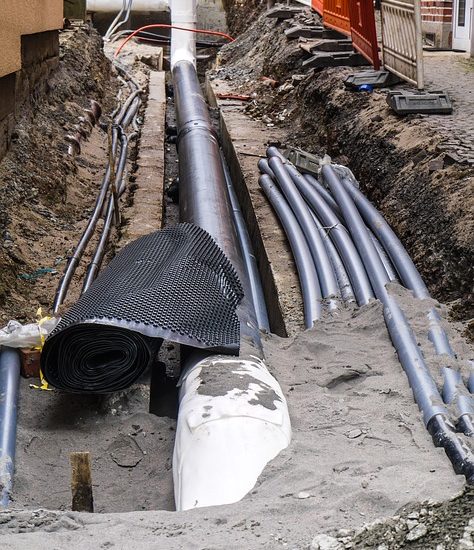US EPA invites applications for WIFIA loans to finance $10 billion in water infrastructure upgrades
- November 14, 2018
- Posted by: administrator
- Category: Investment and Finance, North America

The U.S. Environmental Protection Agency (EPA) is inviting 39 projects in 16 states and D.C. to apply for Water Infrastructure Finance and Innovation Act (WIFIA) loans.
Together, the selected borrowers will receive WIFIA loans totaling approximately $5 billion to help finance over $10 billion in water infrastructure investments and create up to 155,000 jobs.
“Through WIFIA, EPA is playing an integral role in President Trump’s efforts to improve and upgrade our nation’s water infrastructure and ensure all Americans have access to clean and safe water,” said EPA Acting Administrator Andrew Wheeler. “This year, EPA will help finance over $10 billion in water infrastructure investments that will create up to 155,000 jobs, upgrade aging infrastructure, reduce lead exposure, and improve the lives of millions of Americans across the country.”
EPA’s WIFIA loans will allow large and small communities across the country to implement projects to address two national water priorities – providing for clean and safe drinking water including reducing exposure to lead and other contaminants and addressing aging water infrastructure.
EPA received 62 letters of interest from both public and private entities in response to the 2018 WIFIA Notice of Funding Availability (NOFA). After a robust, statutorily required review process, the WIFIA Selection Committee chose the following 39 prospective borrowers’ projects to submit applications for loans:
- City of Phoenix; Water Main Replacement Program; $49 million (Arizona)
- San Mateo-Foster City Public Financing Authority; San Mateo Wastewater Treatment Plant Upgrade and Expansion Project; $277 million (California)
- Coachella Valley Water District; Coachella Valley Stormwater Channel Improvement Project; $22 million (California)
- Poseidon Resources (Channelside) LP; Carlsbad Intake Project; $32 million (California)
- City of Stockton Public Financing Authority; Regional Wastewater Control Facility Modifications Project; $53 million (California)
- Silicon Valley Clean Water; SVCW RESCU; $181 million (California)
- City of Sunnyvale; Sunnyvale Cleanwater Program Phase 2; $166 million (California)
- San Juan Water District; Hinkle and Kokila Reservoir Rehabilitation and Replacement; $12 million (California)
- City of Los Angeles; Donald C. Tillman Advanced Water Purification Facility; $185 million (California)
- Inland Empire Utilities Agency; RP-5 Expansion Project; $138 million (California)
- Sanitation District No. 2 of Los Angeles County; Joint Water Pollution Control Plant Effluent Outfall Tunnel; $426 million (California)
- City of Antioch; Brackish Water Desalination Project; $32 million (California)
- Coachella Valley Water District; North Indio Regional Flood Control Project; $29 million (California)
- District of Columbia Water and Sewer Authority; Comprehensive Infrastructure Repair, Rehabilitation and Replacement Program; $144 million (District of Columbia)
- Florida Keys Aqueduct Authority; Florida Keys Imperiled Water Supply Rehabilitation; $45 million (Florida)
- North Miami Beach Water; NMB Water Regional Potable Water Improvements; $62 million (Florida)
- Miami-Dade Water and Sewer Department; Wastewater Treatment Plant (WWTP) Electrical Distribution Building Upgrade; $343 million (Florida)
- Tohopekaliga Water Authority; Accelerated Gravity Sewer Assessment and Rehabilitation Project; $32 million (Florida)
- Pinellas County Utilities; Water Reclamation Facility Improvements; $13 million (Florida)
- DeKalb County Government; Priority Areas Sewer Assessment & Rehabilitation Program (PASARP) Consent Decree Packages; $251 million (Georgia)
- City of Atlanta; North Fork Peachtree Creek Tank and Pump Station; $55 million (Georgia)
- City of Wichita; Northwest Water Treatment Facility (NWWTF); $270 million (Kansas)
- City of Frontenac; Water Supply, Treatment, Distribution and Storage Improvements and Additions; $5 million (Kansas)
- Louisville and Jefferson County Metropolitan Sewer District; Upper Middle Fork Pump Station (UMFPS); $44 million (Kentucky)
- Louisville and Jefferson County Metropolitan Sewer District; Ohio River Flood Protection Pump Station Capacity Upgrade; $118 million (Kentucky)
- Louisville and Jefferson County Metropolitan Sewer District; Morris Forman Biosolids Processing Solution; $88 million (Kentucky)
- American Water Capital Corporation; St. Louis Area Water Main Replacement and Lead Abatement Program; $84 million (Missouri)
- Kansas City Missouri Water Services Department; Blue River WWTP Biosolids Facility Project; $51 million (Missouri)
- American Water Capital Corp. (AWCC)-Joplin; Joplin Water Supply Reservoir – Joplin, Missouri; $103 million (Missouri)
- City of Cortland; City of Cortland Clinton Avenue Gateway Project; $9 million (New York)
- Monroe County; Frank E. Van Lare Secondary Treatment Upgrades; $15 million (New York)
- Brunswick County; Northwest Water Treatment Plant 36 MGD Improvements Project; $74 million; (North Carolina)
- Enid Municipal Authority; Enid KLWS Pipeline; $53 million (Oklahoma)
- City of Hillsboro and Tualatin Valley Water District; Willamette Water Supply Program (WWSP); $617 million (Oregon)
- City of Lancaster; Sewer System Improvements; $22 million (Pennsylvania)
- Narragansett Bay Commission; CSO Phase III Facilities; $251 million (Rhode Island)
- City of Memphis; T.E. Maxson Wastewater Treatment Facility Process and Biosolids Upgrades Program; $144 million (Tennessee)
- City of Seattle; Ship Canal Water Quality Project; $197 million (Washington)
- City of Waukesha Water Utility; Great Lakes Water Supply Project (Great Water Alliance [GWA] Program); $116 million (Wisconsin)
Established by the Water Infrastructure Finance and Innovation Act of 2014, the WIFIA program is a federal loan and guarantee program at EPA that aims to accelerate investment in the nation’s water infrastructure by providing long-term, low-cost supplemental credit assistance for regionally and nationally significant projects.
According to EPA’s estimate of national drinking water and wastewater needs, over $743 billion is needed for water infrastructure improvements. EPA’s WIFIA program plays an important part in fulfilling this need and in the President’s Infrastructure Plan, which calls for expanding project eligibility.
To date, EPA has issued four loans totaling over $1 billion in WIFIA credit assistance. Combined, the four projects will create over 5,000 jobs.
Of the selected projects, 12 projects will reduce lead or other drinking water contaminants and 37 will address aging infrastructure. Click here for more information about the 39 projects
